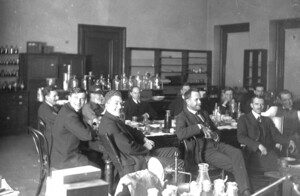- John Philip Trinkaus
- Early Life
- Trink’s Undergraduate Research at Wesleyan University
- Trink's First Visit to the MBL
- Trink and the MBL Embryology Course
- Trink's Graduate Research at Johns Hopkins University
- New Location & New Research Problem
- Fundulus as Choice Organism
- Trink's work on the Yolk Syncytial Layer (YSL) in Fundulus Epiboly
- Trink’s MBL Research on Cell Motility with C. A. Tickle
- Conclusion
- Alfred Huettner
- Cathy Norton
- China at the MBL: 1920-1945
- Collecting at the MBL
- Cyclins at the MBL
- Edmund Beecher Wilson
- Edwin Grant Conklin
- Envisioning the MBL: Whitman’s Efforts to Create an Independent Institution
- Eugene Bell Center for Regenerative Biology and Tissue Engineering 2010-2018
- Shinya Inoué: Capturing Dynamic Cellular Processes
- Squids, Axons, and Action Potentials: Stories of Neurobiological Discovery
- The Biological Bulletin
- The Ecosystems Center (1975-2018)
- The MBL Embryology Course 1939
- The Marine Biological Laboratory
- The Neurobiology of Vision at the MBL
- Using Biodiversity
- Collecting Methods & Surveys
- “Report upon the Invertebrate Animals of Vineyard Sound and Adjacent Waters, with an account of the Physical Features of the Reg
- “A Biological Survey of the Waters of Woods Hole and Vicinity. Part III. A Catalogue of the Marine Fauna” (1913)
- Methods for Obtaining and Handling Marine Eggs and Embryos (1957)
- Experiments
- Supply & Sale
- Collecting Methods & Surveys
- Viktor Hamburger and Experimental Embryology
- Visual Media in Embryology
- Woods Hole 150
Columbia University collected an extraordinary group in the Biology Department in the 1920s. Edmund Beecher Wilson, Thomas Hunt Morgan, and the students and associates who joined them made up a dynamic, creative, and fascinating community. People wandered into Morgan’s lab to get bananas (used as food for the Drosophila Morgan was studying) and talked about ideas and experiments. The Sturtevants, Lancefields, and many others made up the group of friends who visited each other, had picnics together, attended each others’ weddings, and made up the life of science and families. Huettner’s photographs capture the community at work and play at Columbia and the Marine Biological Laboratory, where they went for summer research and fun.
Suggested citation
Maienschein, Jane. 2014. "Alfred Huettner." MBL History Project digital exhibit. http://history.archives.mbl.edu/exploring/exhibits/alfred-huettner
Bibliography
- Donald Lancefield, “Alfred F. Huettner, Scientist and Teacher,” Science. 1955: 122: 953.
- Jo Hall, “Brothers excelled in Photography,” Mobridge Tribune (June 15, 1988) p. 7

